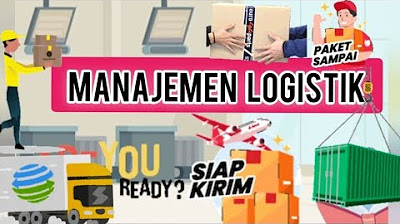What is Transportation Management? Supply Chain 101
Summary
TLDRThis video delves into transportation management within supply chain logistics. It explains how the efficient planning, execution, and optimization of goods movement can reduce costs, improve efficiency, and enhance customer satisfaction. Key players such as shippers, carriers, and third-party logistics providers (3PLs) are highlighted, alongside essential processes like freight planning, carrier selection, and performance analysis. A real-world example of an online retailer's order fulfillment illustrates how transportation management systems (TMS) streamline operations, from inventory checks to real-time tracking and final delivery, ensuring a smooth customer experience.
Takeaways
- 😀 Transportation management ensures goods are moved efficiently, cost-effectively, and on time, with a focus on the right carriers, routes, and timing.
- 😀 Efficient transportation management can significantly reduce transit times and minimize wasted resources, enhancing overall supply chain performance.
- 😀 Smart transportation management helps businesses save money by reducing shipping costs, which is often one of the largest supply chain expenses.
- 😀 Fast and reliable shipping directly contributes to customer satisfaction and can encourage repeat business.
- 😀 Key players in transportation management include shippers (responsible for sending goods), carriers (responsible for transporting goods), receivers (end customers), 3PLs (third-party logistics providers), and TMS (transportation management systems).
- 😀 A TMS is critical for planning, executing, tracking shipments, and optimizing routes, saving costs and improving operational efficiency.
- 😀 Freight planning involves deciding the best shipping routes and modes (truck, rail, air, sea) and optimizing load space for maximum resource use.
- 😀 Carrier selection is crucial in transportation management, focusing on factors like cost, reliability, transit times, and sustainability efforts.
- 😀 Real-time tracking and visibility are essential for businesses and customers to monitor shipment status, address delays, and stay informed throughout transit.
- 😀 Post-delivery performance analysis helps businesses assess the efficiency of their transportation processes and optimize future shipments for better results.
Q & A
What is transportation management?
-Transportation management involves planning, executing, and optimizing the movement of goods. It ensures products are transported efficiently, on time, in good condition, and at the right cost.
Why is transportation management important?
-It is crucial because it improves efficiency, reduces costs, and enhances customer satisfaction by ensuring timely and reliable product deliveries.
What are the key players in transportation management?
-The key players include shippers (the senders of goods), carriers (the companies responsible for moving goods), receivers (the end customers), third-party logistics providers (3PLs), and transportation management systems (TMS).
How does transportation management contribute to cost savings?
-Transportation management helps reduce shipping costs by optimizing routes, consolidating shipments, and selecting the most cost-effective carriers and transportation methods.
What is a transportation management system (TMS)?
-A TMS is a software solution that helps businesses plan, execute, and track shipments. It recommends optimal routes, consolidates shipments, provides real-time tracking, and offers performance analytics.
What is the role of carriers in transportation management?
-Carriers are responsible for physically transporting goods. They can be trucking companies, railroads, shipping lines, freight airlines, or delivery services like FedEx or UPS.
What is freight planning, and why is it important?
-Freight planning involves determining the best routes and modes of transport, optimizing loads, and ensuring the efficient use of space and resources. It is essential to reduce costs and improve transit times.
How does real-time tracking benefit transportation management?
-Real-time tracking provides visibility into the shipment's location, allowing businesses and customers to track progress, manage delays, and react quickly to any issues during transit.
Can you explain the process of last mile delivery?
-Last mile delivery involves the final leg of the journey, where goods are delivered to the customer's doorstep. This step is often handled by local delivery partners like FedEx, UPS, or same-day couriers.
How does transportation management improve customer satisfaction?
-Transportation management enhances customer satisfaction by ensuring fast, reliable, and on-time deliveries. Customers are kept informed with notifications, and any potential issues are managed efficiently.
Outlines

This section is available to paid users only. Please upgrade to access this part.
Upgrade NowMindmap

This section is available to paid users only. Please upgrade to access this part.
Upgrade NowKeywords

This section is available to paid users only. Please upgrade to access this part.
Upgrade NowHighlights

This section is available to paid users only. Please upgrade to access this part.
Upgrade NowTranscripts

This section is available to paid users only. Please upgrade to access this part.
Upgrade NowBrowse More Related Video

What is Logistics & Logistics Management | What are Modes of Transport | How to select TransMode

Manajemen Logistik #1 Pengantar

What is Logistics Management? Meaning, Importance, Basic Functions & Strategies - AIMS UK

WHAT is the DIFFERENCE between SUPPLY CHAIN and LOGISTICS?

O Impacto da Logística Verde na Sustentabilidade

CADEIA de SUPRIMENTOS e LOGÍSTICA
5.0 / 5 (0 votes)